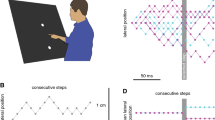Abstract.
Delays in the transmission of sensory and motor information prevent errors from being instantaneously available to the central nervous system (CNS) and can reduce the stability of a closed-loop control strategy. On the other hand, the use of a pure feedforward control (inverse dynamics) requires a perfect knowledge of the dynamic behavior of the body and of manipulated objects. Sensory feedback is essential both to accommodate unexpected errors and events and to compensate for uncertainties about the dynamics of the body. Experimental observations concerning the control of posture, gaze and limbs have shown that the CNS certainly uses a combination of closed-loop and open-loop control. Feedforward components of movement, such as eye saccades, occur intermittently and present a stereotyped kinematic profile. In visuo-manual tracking tasks, hand movements exhibit velocity peaks that occur intermittently. When a delay or a slow dynamics are inserted in the visuo-manual control loop, intermittent step-and-hold movements appear clearly in the hand trajectory. In this study, we investigated strategies used by human subjects involved in the control of a particular dynamic system. We found strong evidence for substantial nonlinearities in the commands produced. The presence of step-and-hold movements seemed to be the major source of nonlinearities in the control loop. Furthermore, the stereotyped ballistic-like kinematics of these rapid and corrective movements suggests that they were produced in an open-loop way by the CNS. We analyzed the generation of ballistic movements in the light of sliding control theory assuming that they occurred when a sliding variable exceeded a constant threshold. In this framework, a sliding variable is defined as a composite variable (a combination of the instantaneous tracking error and its temporal derivatives) that fulfills a specific stability criterion. Based on this hypothesis and on the assumption of a constant reaction time, the tracking error and its derivatives should be correlated at a particular time lag before movement onset. A peak of correlation was found for a physiologically plausible reaction time, corresponding to a stable composite variable. The direction and amplitude of the ongoing stereotyped movements seemed also be adjusted in order to minimize this variable. These findings suggest that, during visually guided movements, human subjects attempt to minimize such a composite variable and not the instantaneous error. This minimization seems to be obtained by the execution of stereotyped corrective movements.
Similar content being viewed by others
Author information
Authors and Affiliations
Additional information
Received: 18 February 1997 / Accepted in revised form: 29 July 1997
Rights and permissions
About this article
Cite this article
Hanneton, S., Berthoz, A., Droulez, J. et al. Does the brain use sliding variables for the control of movements?. Biol Cybern 77, 381–393 (1997). https://doi.org/10.1007/s004220050398
Issue Date:
DOI: https://doi.org/10.1007/s004220050398




